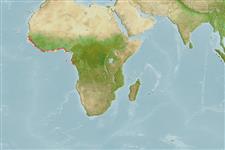Common names from other countries
>
Clupeiformes (Herrings) >
Dorosomatidae (Gizzard shads and sardinellas)
Etymology: Pellonula: Latin, pellis = skin + Latin, nullus = no one (Ref. 45335); leonensis: Species is named after the vernacular name in Bambara, 'miri', given by the local fisherman in Mali (Ref. 2756).
More on author: Boulenger.
Environment: milieu / climate zone / depth range / distribution range
生態学
海; 新鮮な水; 汽水性の 外洋の; 昇流魚 (Ref. 51243). Tropical; 17°N - 5°S, 18°W - 24°E (Ref. 26213)
Africa: freshwater rivers of West Africa (Ref. 188, 2244), in lagoons, lakes, lower and upper courses of rivers from Senegal to Cross River (Ref. 81269), including upper reaches of Niger and lower parts of Benue River (Ref. 188); and lagoons and lower and middle courses of coastal rivers from Cameroon to Democratic Republic of Congo (Ref. 2244, 81631). Reported from the Léfini River (Ref. 88782), but apparently not in upper parts of Congo system (Ref. 188). Also reported from Atlantic Ocean, including beaches at Hann near Dakar in Senegal and near Pointe Noire in Congo Republic (Ref. 188).
Length at first maturity / サイズ / 重さ / 年齢
Maturity: Lm ?, range 3 - ? cm
Max length : 12.1 cm TL オス/雌雄の選別がない; (Ref. 1989); 最大公表体重: 13.50 g (Ref. 2247)
背面の脊椎 (合計) : 0; 背鰭 (合計) : 13 - 19; 肛門の骨: 0; 臀鰭: 16 - 22; 脊つい: 39 - 44. Diagnosis: Body slender to moderately deep, its depth 17-30% of standard length; scutes beginning behind base of first pectoral finray, with 8-15 pre-pelvic and 6-10 post-pelvic scutes, and a total of 17-23 scutes, first pre-pelvic scute as long as following scutes lacking ascending arms; lower jaw very slightly projecting, teeth at symphysis only slightly enlarged; pre-maxillary teeth small and inward pointing, only the tips usually apparent, no strongly marked indentation at centre of jaw; lower gillrakers 20-35, equal to or longer than corresponding gill filaments; silver stripe along flank (Ref. 188, 2244, 81269, 81631). It resembles Pellonula vorax, which has larger and straighter teeth, often pointing forward, and scutes before pectoral fin bases (Ref. 188, 2244, 81269, 81631). The absence of large canine teeth in upper jaw distinguishes it from Odaxothrissa; Microthrissa species are deep-bodied and have a much more slender maxilla compared to Pellonula leonensis (Ref. 188).
Found chiefly in rivers and streams, also man-made and natural lakes (Ref. 188); also in estuaries and lagoons (Ref. 188, 2683). Apparently able to tolerate moderate or even quite high salinities (Ref. 188). It forms enormous shoals in both inshore and offshore regions of Lake Kainji (Ref. 3034). It feeds on terrestrial and aquatic insects, but also ostracods and entomostracans; stomachs containing clupeid fish scales may represent cannibalism (Ref. 188). Reproduction occurs in rivers and lakes, and may be also in estuaries and coastal lagoons (Ref. 2683). It breeds from July to September in Lake Volta (Ref. 188).
Reproduction occurs in rivers and lakes, and may be also in estuaries and coastal lagoons (Ref. 2683).
Gourène, G. and G.G. Teugels, 1991. Révision du genre Pellonula des eaux douces africaines (Pisces: Clupeidae). Ichthyol. Explor. Freshwat. 2(3):213-225. (Ref. 2244)
CITES (Ref. 128078)
Not Evaluated
Human uses
水産業: 少数商業の; 餌: occasionally
用具
特記事項
XMLをダウンロードして下さい
インターネットの情報源
Estimates based on models
Preferred temperature (Ref.
115969): 24.4 - 27.9, mean 26.7 (based on 62 cells).
Phylogenetic diversity index (Ref.
82804): PD
50 = 0.7500 [Uniqueness, from 0.5 = low to 2.0 = high].
Bayesian length-weight: a=0.00891 (0.00771 - 0.01030), b=3.02 (2.98 - 3.06), in cm Total Length, based on LWR estimates for this species (Ref.
93245).
栄養段階 (Ref.
69278): 3.3 ±0.39 se; based on food items.
回復力 (Ref.
120179): 高い, 15か月以下の倍増期間の最小個体群 (Preliminary K or Fecundity.).
Fishing Vulnerability (Ref.
59153): Low vulnerability (14 of 100).
